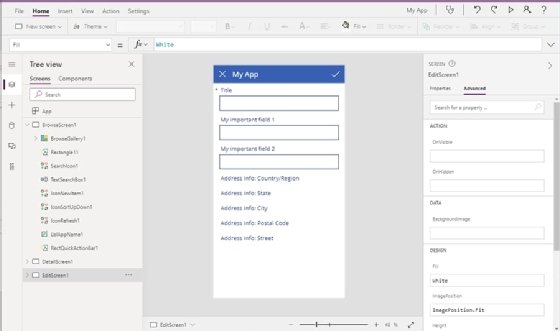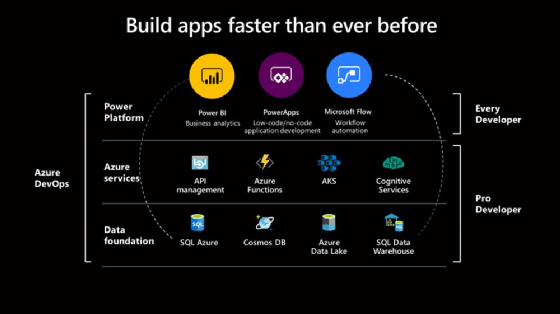Microsoft Power Apps
What is Microsoft Power Apps?
Power Apps is a suite of Microsoft products that enable both developers and nontechnical users to build custom applications to fulfill various business needs. The Power Apps suite includes a variety of applications, services and connectors, as well as a data platform, which together create a rapid app development environment requiring little to no coding expertise to use.
Power Apps is a popular suite of low-code services used to build business apps. In addition to low-code/no-code app development, the platform combines self-service analytics and automation. The Microsoft Azure cloud hosts the Power Apps application suite that can use enterprise data stored on a singular data platform such as Microsoft Dataverse or in various data sources such as SharePoint, Microsoft 365, Dynamics 365 or Microsoft SQL Server. Application programming interfaces (APIs) enable such data connections.
Developers can use the Power Apps platform to programmatically interact with underlying data and metadata and integrate it with external data. They can also apply business logic and create custom connectors as required.
Benefits of Power Apps
Microsoft rolled out Power Apps in late 2015 as a platform-as-a-service (PaaS) offering. The platform and development tools make it possible for nontechnical users to create, manage and share business apps with ease, simplifying and accelerating the app-building process by enabling any user to build a feature-rich, customized app without writing code.

The Power Apps platform features an intuitive visual design and drag-and-drop functionality. Its user interface (UI) mimics applications such as Microsoft PowerPoint that many users are familiar with and comfortable using. The platform is extensible and can interact with data and create connectors and apply business logic to any app created.
Apps built using Power Apps provide advanced workflow capabilities to convert manual processes into automated processes. These apps can run seamlessly on iOS, Android and Windows devices, providing flexibility and responsive user experiences.
Apps built with Power Apps
Business users can create many types of apps using Power Apps. Two of the most popular are canvas apps and model-driven apps.
Canvas apps can be built for web, mobile and tablet applications. App makers and creators can build these apps using a variety of sources, including:
- Dispersed data sources.
- A singular data platform such as Dataverse.
- An entirely blank canvas.
- Microsoft AppSource, which is embedded in the Microsoft 365 apps home page.

Power Apps provides the flexibility to build any kind of desired user experience and interface. App creators can connect their app interfaces to upwards of 200 data sources.
Developers can build model-driven apps from core business data and processes in the Dataverse. These apps model forms, views, process flows, business rules and other components. Power Apps automatically generates UIs for model-driven apps that are responsive across devices.
In addition to canvas apps and model-driven apps, Power Apps lets developers build micro apps known as cards. These apps have lightweight UI elements that can be replicated across multiple applications without any coding or IT expertise. Cards can surface business data through Power Platform connectors. They can also be customized using business logic.

Power Apps for professional developers
Although Power Apps is designed to be friendly to non-technical users, professional developers can also use it to build and customize new apps. Developers or app creators can apply their programming skills to Power Apps to do the following:
- Create data and metadata.
- Apply server-side logic using Azure functions, plugins and workflow extensions.
- Apply client-side logic using JavaScript
- Use virtual entities and webhooks to integrate with external data.
- Build custom connectors.
Power Apps also help developers embed apps into website experiences to create more integrated, user-focused pages.
AI Builder in Power Apps
Al Builder is a turnkey tool that directly integrates with Power Apps. It enables developers to build AI models through a point-and-click experience using Power Apps.
AI Builder supports many model types for different business scenarios. For example, a user can refine a custom object detection model to detect products in images. Another user can use a prebuilt scanning model to automate reports and receipts, while a third user can use a business-tailored custom prediction model to design marketing campaigns using historical data.
AI Builder and Power Apps together provide a way for business users to include intelligence in business processes, canvas apps and model-driven apps.

Power Apps and Microsoft Dataverse
Microsoft Dataverse is a low-code data platform that lets organizations create and run thousands of applications intelligently at scale. It can integrate data from multiple sources into a single source.
Dataverse stores its data in an automatic set of tables, but users can also create and populate custom tables specific to their organizations using Power Query. These tables are manageable and secure, provide easy access to Dynamics 365 data, use rich metadata and ensure data quality with advanced logic and validation.
Users can use Power Apps to connect their custom business apps to the data stored in Dataverse. They can also build apps by using Power Apps and Dataverse together directly without any integrations. The business logic and rules already defined in Dataverse tables are then applied to apps created in Power Apps to ensure data consistency.
Explore Microsoft Power Apps use cases for organizations and review Power Apps best practices to build business apps.






